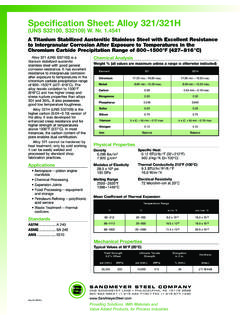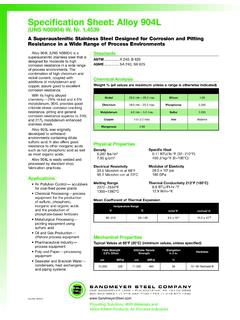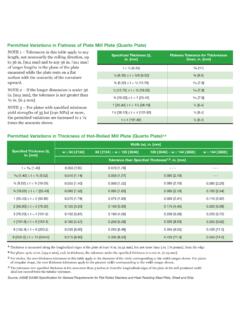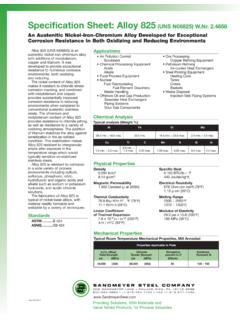Transcription of Most Widely Used Austenitic Stainless Steel, a Versatile ...
1 Alloy 304/304L (UNS S30400/S30403) is the most Widely utilized 18-8 chromium-nickel Austenitic Stainless steel. It is an economical and Versatile corrosion resistant alloy suitable for a wide range of general purpose applications. It is common practice for 304L to be dual certified as 304 and 304L. The low carbon chemistry of 304L combined with an addition of nitrogen enables 304L to meet the mechanical properties of 304. Alloy 304/304L resists atmospheric corrosion, as well as, moderately oxidizing and reducing environments. The alloy has excellent resistance to intergranular corrosion in the as-welded condition. Alloy 304/304L has excellent strength and toughness at cryogenic temperatures. Alloy 304/304L is non-magnetic in the annealed condition, but can become slightly magnetic as a result of cold working or welding.
2 It can be easily welded and processed by standard shop fabrication Chemical and Petrochemical Processing pressure vessels, tanks, heat exchangers, piping systems, flanges, fittings, valves and pumps Food and Beverage Processing Medical Mining Petroleum Refining Pharmaceutical Processing Power Generation nuclear Pulp and PaperStandardsASTM ..A 240 ASME ..SA 240 AMS ..5511/5513QQ-S ..766 Specification Sheet: Alloy 304/304L (UNS S30400, S30403) W. Nr. , Widely Used Austenitic Stainless Steel, a Versatile Corrosion Resistant Alloy for General Purpose ApplicationsAlloy 304-304L 06 STEEL COMPANYONE SANDMEYER LANE PHILADELPHIA, PA 19116-3598800-523-3663 +1-215-464-7100 FAX +1-215-677-1430 Providing Solutions, With Materials andValue Added Products, for Process IndustriesPhysical PropertiesDensity lbs / in3 g /cm3 Modulus of Elasticity x 106 psi 200 GPaMelting Range 2550 2590 F 1398 1421 CSpecific Heat BTU/lb- F (32 212 F) 500 J/kg- K (0 100 C)Thermal Conductivity 212 F (100 C)
3 BTU/hr/ft2/ft/ F W/m- KElectrical Resistivity Microhm-in at 68 F 74 Microhm-cm at 20 CMean Coefficient of Thermal Expansion 68 212 20 100 x 10-6 x 10-6 68 932 20 500 x 10-6 x 10-6 68 1600 20 870 x 10-6 x 10-6 Temperature Rangein/in/ F cm/cm C F CMechanical PropertiesTypical*ASTMType 304 Type 304L* inch plate Offset Yield Strength, ksi 42 30 min. 25 min. Ultimate Tensile Strength, ksi 87 75 min. 70 min. Elongation in 2 inches, % 58 40 min. 40 min. Reduction in Area, % 70 Hardness, Rockwell B 82 92 max. 92 AnalysisWeight % (all values are maximum unless a range is otherwise indicated) Chromium min. max. min. max. Nickel min. max. min. max. Carbon Manganese Phosphorus Sulfur Silicon Nitrogen Iron Balance Balance Element304304 LAlloy 304/304L has good resistance to atmospheric corrosion, foods and beverages and to many organic and inorganic chemicals in moderately oxidizing to moderately reducing environments.
4 The high chromium content of the alloy provides resistance to oxidizing solutions such as nitric acid up to 55% weight and up to 176 F (80 C). Alloy 304/304L also resists moderately aggressive organic acids such as acetic. The nickel present in the alloy provides resistance to moderately reducing solutions such as pure phosphoric acid, whatever the concentration, in cold solutions and up to 10% diluted hot solutions. The alloy can also operate successfully in caustic solutions free of chlorides or fluorides at moderate 304/304L does not perform well in more highly reducing environments such as those containing chlorides and sulfuric 304/304L performs well in fresh water service with low levels of chlorides (less than 100ppm). At higher chloride levels the grade is susceptible to crevice corrosion and pitting.
5 For successful performance under these more severe conditions, higher molybdenum content is need such as 316/316L. Alloy 304/304L is not recommended for service in marine environments. In most instances, the corrosion resistance of Alloys 304, 304L and 304H will be roughly equal in most corrosive environments. However, in environments that are sufficiently corrosive to cause intergranular corrosion of welds and heat-affected zones Alloy 304L should be used because of its low carbon content. Corrosion Resistanceps = pitting can occur ps = pitting/crevice corrosion can occurLowest Temperature ( F) at Which the Corrosion Rate Exceeds 5 mpy Hydrochloric Acid >Boiling >Boiling >Boiling >Boiling 1% Hydrochloric Acid 86p 86 185 >Boiling 10% Sulfuric Acid 122 140 167 60% Sulfuric Acid <54 <59 <57 96% Sulfuric Acid 113 77 86 85% Phosphoric Acid 176 203 194 203 10% Nitric Acid >Boiling >Boiling >Boiling >Boiling 65% Nitric Acid 212 212 221 230 80% Acetic Acid 212p >Boiling >Boiling >Boiling 50% Formic Acid 50 104 194
6 194 50% Sodium Hydroxide 185 194 194 230 83% Phosphoric Acid + 2% Hydrofluoric Acid 113 149 122 140 60% Nitric Acid + 2% Hydrochloric Acid >140 >140 >140 >140 50% Acetic Acid + 50% Acetic Anhydride >Boiling 248 212 230 1% Hydrochloric Acid + Ferric Chloride 68p 77p 113ps 203ps 10% Sulfuric Acid + 2000ppm Cl- + N2 77 95 122 10% Sulfuric Acid + 2000ppm Cl- + SO2 <<59p <59 104 WPA1, High Cl- Content <<50 50 113 203 WPA2, High F- Content <<50 50 140 167 CORROSION ENVIRONMENT Type Type 2205 2507 304 316L (UNS S32205)
7 1 54 2 54 WPA P2O5 Cl- F- H2SO4 Fe2O3 Al2O3 SiO2 CaO MgOSANDMEYERSTEEL COMPANYThe information and data in this product data sheet are accurate to the best of our knowledge and belief, but are intended for informational purposes only, and may be revised at any time without notice. Applications suggested for the materials are described only to help readers make their own evaluations and decisions, and are neither guarantees nor to be construed as express or implied warranties of suitability for these or other DataAlloy 304/304L can be easily welded and processed by standard shop fabrication Forming Working temperatures of 1652 2102 F (750 1150 C) are recommended for most hot working processes.
8 For maximum corrosion resistance, the material should be annealed at 1900 F (1038 C) minimum and water quenched or rapidly cooled by other means after hot Forming The alloy is quite ductile and forms easily. cold working operations will increase the strength and hardness of the alloy and might leave it slightly Alloy 304/304L can be readily welded by most standard processes. A post weld heat treatment is not Alloy 304/304L is subject to work hardening during deformation and is subject to chip breaking. The best machining results are achieved with slower speeds, heavier feeds, excellent lubrication, sharp tooling and powerful rigid 6 .23 .019 13 18 59 3 .11 .016 20 25 82 1 .04 .008 26 31 6 .23 .019 75 85 246 3.
9 11 .016 90 100 1 .04 .008 110 120 .06 .0012 .0020 18 23 59 3 .11 .0016 .0024 19 24 6 .23 .0020 .0027 20 25 82 .06 .0007 .0012 10 14 3 .11 .0020 .0024 12 16 6 .23 .0031 .0035 12 16 12 .48 .0035 .0039 12 16 .002 .004 12 22 ProfilingHigh Speed SteelCarbideHigh Speed SteelHigh Speed SteelHigh Speed SteelCutting OilDry or CuttingOilCutting OilCutting OilCutting Oil Feed-mm/t Feed-in/t Speed-m/min Speed-ft/min Feed-mm/t Feed-in/t Speed-m/min Speed-ft/minDrill mmDrill inDepth-mmDepth-in Feed-mm/t Feed-in/t Speed-m/min Speed-ft/minDepth of cut-mmDepth of cut-in Feed-mm/t Feed-in/t Speed-m/min Speed-ft/mi









